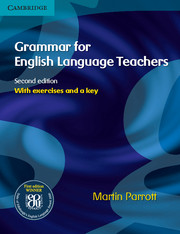Introduction to Part B
Published online by Cambridge University Press: 09 February 2023
Summary
English language courses generally pay a great deal of attention to different forms of verbs and people often argue that this attention is excessive. However, as teachers we still need to know and understand the full range of forms and uses.
In Chapters 10–19 we look at verbs under a variety of guises:
Tense and aspect
This book follows most modern coursebooks in using the term ‘tense’ to refer to the large variety of forms we use to convey information about time through our choice of verbs.
The term ‘tense’, however is sometimes used to refer only to the present simple (e.g. I eat) and past simple (e.g. I ate) as these are the only two cases in which the form of the main verb changes (in other cases we add further verbs to the main verb). Many languages have no system of tenses; time is indicated through the use of words or phrases like tomorrow or last year, or is simply understood from the context.
Languages which have no tense system may (like Chinese), however, have a system of ‘aspect’. Aspect, typically, expresses whether actions or events are finished or unfinished, temporary or protracted. English has two aspects: perfect (also known as ‘perfective’) and continuous (also known as ‘progressive’). The perfect aspect creates a link between two time periods; it usually suggests looking back at something from a later point in time. The continuous aspect usually suggests that an activity is still taking place, viewed from a particular point in time, and the verbs used are most commonly those which describe some kind of activity.
Perfect aspect: events viewed retrospectively:
have/had/will have. etc. + past participle, e.g. I have seen him.
Continuous aspect: events viewed as being in progress:
be/will be etc. + -ing form, e.g. I am eating
While it may help learners to understand these general principles, in reality the meanings of these aspects vary in use and, from a practical point of view, it is more useful to teach distinct forms one by one, pointing out similarities with other ‘tenses’ as appropriate.
- Type
- Chapter
- Information
- Grammar for English Language Teachers , pp. 138 - 139Publisher: Cambridge University PressPrint publication year: 2010



